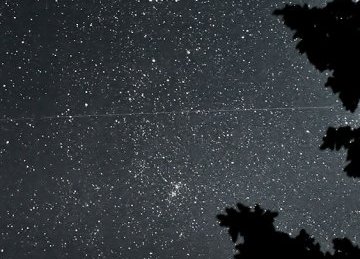 Discovery and the ISS are orbiting Earth. Would you like to see them? Sign up for Spaceweather PHONE.
Discovery and the ISS are orbiting Earth. Would you like to see them? Sign up for Spaceweather PHONE.
QUIET SUN: Solar activity is extremely low. Only one tiny sunspot is visible, active region 900, and it poses no threat for solar flares.
INFLATABLE SATELLITE: On July 12th, a Russian rocket blasted off with unusual cargo: an inflatable satellite named Genesis I. Five hundred kilometers above Earth, Genesis expanded to full size (10 meters wide), and is now visible in the night sky. On July 15th, Genesis cut across the starry skies of Divide, Colorado, where Ginger Mayfield took its picture:

"The satellite was about as bright as a 2nd magnitude star--very easy to see," says Mayfield.
Genesis belongs to Bigelow Aerospace, a private company with plans to deploy a manned space station in Earth orbit. The station would be assembled from inflatable modules. Genesis is a one-third scale prototype; it will circle Earth for five years while researchers study its performance and durability.
Would you like to see Genesis? We can call you when it's about to fly over your home town.
GOLDEN GATE CORONA: When looking for sun coronas, stand in the shadows! Anything that blocks the glare of the sun improves visibility. On July 13th, Mila Zinkova used the Golden Gate Bridge to block the sun, and here is what she saw:

The corona had a strangely 3-dimensional, nearby feel, reports Zinkova. That's because the water droplets responsible for the colorful rings were swirling in and out of the bridge's great towers--not miles high as usual. Conclusion: Shadows are good, but foggy shadows are even better.

